How to Remove Water Stains from Wood with Common Household Products
Updated: Apr. 19, 2024
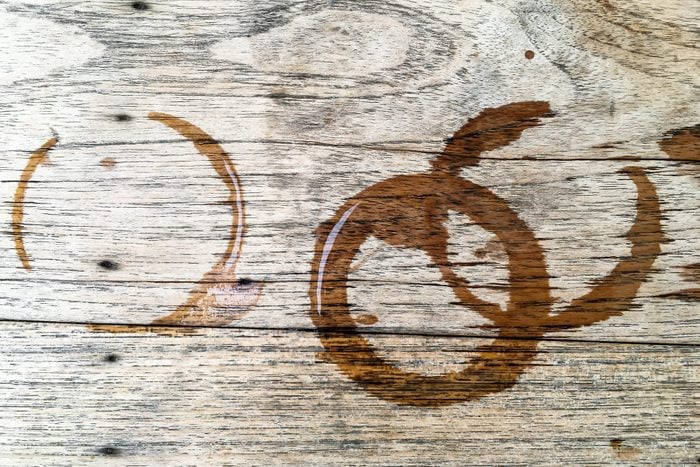
With a little elbow grease and the right ingredients, you can remove water stains from wood and bring your furniture back to an unblemished shine
Ack! While you were doing your regular weekly cleaning, you found the glass someone in your family left on the coffee table—and a cloudy ring blooming beneath it. Time to panic? No, but definitely time to learn how to remove water stains from wood. Readers Digest got expert advice from four cleaning pros to help save your wooden furniture from accidental damage. With a little elbow grease, these home remedies can bring your wooden furniture back to an unblemished shine.
Get Reader’s Digest’s Read Up newsletter for more cleaning, humor, travel, tech and fun facts all week long.
About the experts
Reviewed for accuracy by: Ann Russell, TikTok’s “cleaning auntie” and the author of How to Clean Everything. |
Determine the type of stain
There are two kinds of water stains: Dark water stains, and light water stains. Which kind of stain you have determines what kind of remedy you should try, and how likely a DIY approach is to fix it.
Dark water stains
Let’s get the bad news out of the way first: A dark water stain is likely to be permanent. It basically means water has breached the finish, breached the wood and settled in. Refinishing the piece entirely may be the only recourse.
White water stains
And now for the good news: A light-colored or milky ring offers more hope for home fixes. That cloudy mark is actually water trapped within the finish, and it can likely be removed.
If the stain is new on newer furniture, after a quick mop-up, keep an eye on it for a few days, says Dan Brister, owner of Pohl Custom Cabinets. Generally, a light, cloudy mark will dry on its own. Brister says that’s because a contemporary finish is less permeable than the older one on grandma’s table. Water can and may evaporate, and residual marks can even be polished out.
It’s a different story for older furniture with light-colored water stains. The chemicals in old finishes are often more porous, allowing liquid to seep deeper and get trapped more tightly. Sometimes a couple of noninvasive water stain removal methods work well in tandem and can save you from a bigger refinishing bill.
How to remove water stains from wood
Try these DIY remedies for removing water stains from wood.
Hair dryer
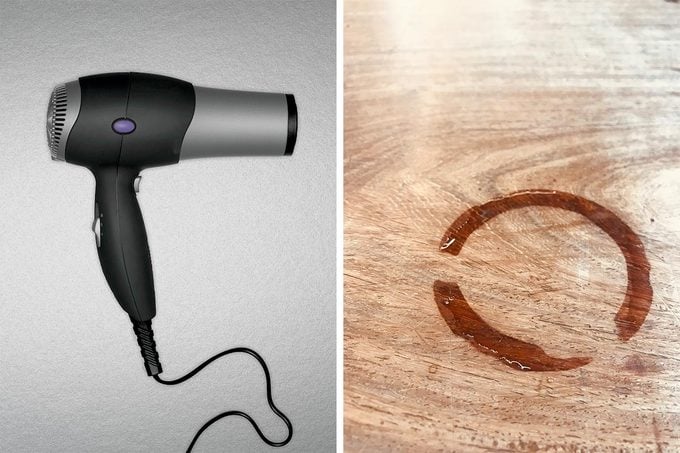
Best for: Recent stains
You don’t necessarily need a chemical product to remove water stains from wood—you might just need your trusty hair dryer. Using a hair dryer’s diffused heat can speed the process of drying water that’s close to the surface. It’s a similar principle to running a fan in a room that’s been flooded.
Directions
- Turn on the hair dryer to its lowest setting.
- Point the hair dryer at the stain for 10 minutes. Avoid getting too close to the wood.
- If the surface feels hot to the touch, let it cool for about 10 to 15 minutes before trying again.
- As the stain dissipates, it might release moisture. When that happens, blot the moisture with a clean cotton cloth.
Tip: If the finish becomes tacky, stop immediately.
Iron
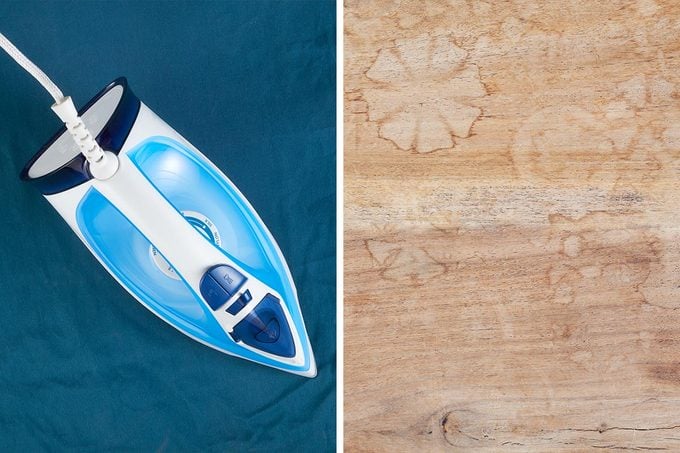
Best for: Old and new furniture with light-colored stains
Brian Kelsey, a licensed contractor and the creator of Ten Minutes With, is a fan of the iron method for how to clean white rings from wood. The goal is to use gentle heat to release a surface water stain and help it evaporate. But be careful: Under no circumstances should you use the steam setting or extra water. As mild as water can be, wood is one of the things you shouldn’t clean with water unless extreme caution is used. Here’s how to do it successfully.
Directions
- Get a clean cotton rag or towel that is free of any blemishes or decals that could transfer to the wood.
- Cover the stain with the cloth.
- Set the iron’s heat on its lowest setting and wait a minute for it to heat up.
- Press the iron on the cloth, and hold it for 30 seconds.
Tip: If this doesn’t work after two to three tries, consider another method. Also avoid heating the furniture surface too much, which may disrupt the finish.
Toothpaste
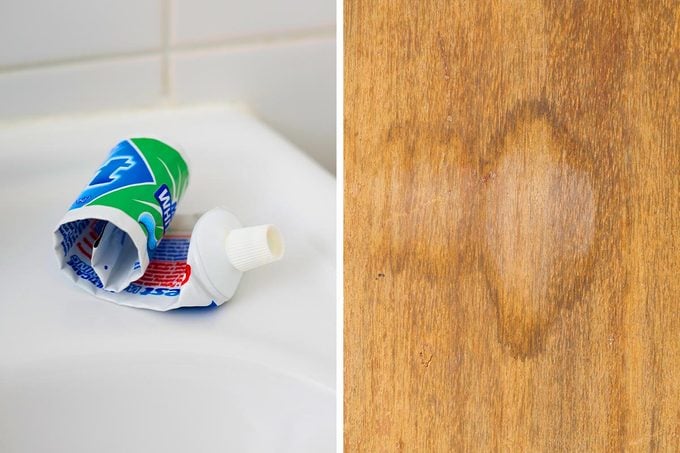
Best for: Cloudy water stains
You might not believe this, but toothpaste can come to the rescue. It’s fast and easy—if you use the right type of toothpaste, that is. Gel toothpaste doesn’t work for this type of stain removal. It’s the mildly abrasive baking soda in white toothpaste that helps draw the water out.
“I find white toothpaste really effective,” says Sabrina Fierman, vice president of New York’s Little Elves, noting that it’s one of her favorite solutions for water stains on wood. “Plus, you find out right away if it works.”
Directions
- Squeeze out a small amount of toothpaste.
- Apply it to the stain in a small circular motion for 30 seconds, making sure to leave it on for no longer than a minute.
- Remove the residue with a damp white cotton cloth. You can also use a hair dryer afterward to dry it off.
Tip: Before trying this method, make sure to test the toothpaste on a small unseen area to confirm it won’t harm your finish.
Toothpaste is also an option for removing permanent marker stains from wood, so put it back in the cabinet for safe-keeping when you’re done!
Salt
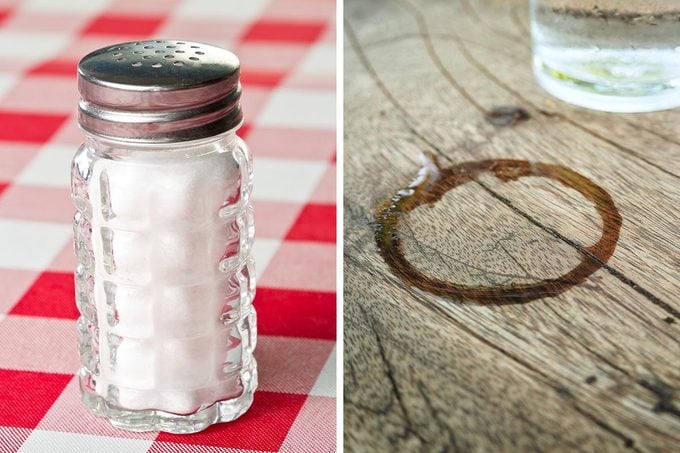
Best for: Light, recent stains
Grace Reynolds, co-founder of Handmaid Cleaning and the American House Cleaners Association, heads to the kitchen for her preferred science-based way to remove water stains from wood. That’s right—salt isn’t just for cooking! “White stains are trapped condensation under the surface. Salt dehydrates,” she explains. “Through osmosis, it pulls the trapped moisture to the surface.”
An important note: While gently rubbing the salt mixture onto the stain can help to remove the stain, it can also irritate the finish, so Reynolds says to proceed with caution if you attempt this.
Directions
- Make a thick paste by mixing a few drops of water with the salt.
- Apply the mixture to the stain without rubbing it in, and let it sit on the stain for 10 to 20 minutes.
- Remove the salt with a dry or damp cloth without pressing down, outside edges first.
- Remove any residual residue with another clean, damp cloth.
Tip: Once the stain is gone, Reynolds likes to follow up with Orange Glo to polish the wood.
FAQs
Does white vinegar remove water stains from wood?
Yes, white vinegar is another popular DIY method to remove water stains from wood.
Directions
- Mix equal parts water and vinegar in a bowl.
- Wet a microfiber cloth with the solution, wringing it out so it’s damp but not dripping wet.
- Gently press the cloth over the stain, letting it sit for an hour.
- Remove and check if stain has lifted.
What should you do if the water stain won’t go away?
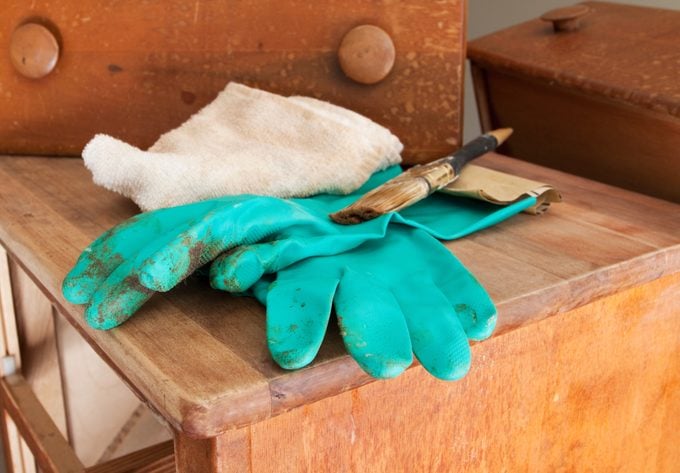
If a water stain won’t go away, you may need to contact a professional for furniture restoration. They can try sanding down the surface to remove the stain from the finish and the wood, and then repairing the piece with a new, unblemished finish.
How do you get water stains out of varnished wood?
You can get water stains out of varnished wood by using various DIY remedies, including using an iron, hair dryer, mayonnaise, toothpaste, salt or vinegar.
Are some water stains on wood permanent?
Unfortunately, some water stains can be permanent. Lighter, cloudy water stains are more likely to be removed, while darker water stains may be permanent unless the piece is sanded and refinished.
Why trust us
At Reader’s Digest, we’re committed to producing high-quality content by writers with expertise and experience in their field in consultation with relevant, qualified experts. For this piece, Betsy Karetnick tapped her experience as a lifestyle writer covering cleaning and organization, and then cleaning expert Ann Russell, author of How to Clean Everything, gave it a rigorous review to ensure that all information is accurate and offers the best possible advice to readers. We verify all facts and data, back them with credible sourcing and revisit them over time to ensure they remain accurate and up to date. Read more about our team, our contributors and our editorial policies.
Sources:
- Sabrina Fierman, vice president of New York’s Little Elves; interviewed, November 2018
- Dan Brister, owner of Pohl Custom Cabinets; interviewed, November 2018
- Brian Kelsey, licensed contractor and host of Ten Minutes With; interviewed, November 2018
- Grace Reynolds, co-founder of Handmaid Cleaning and the American House Cleaners Association; interviewed, November 2018
